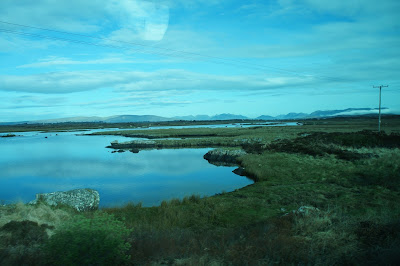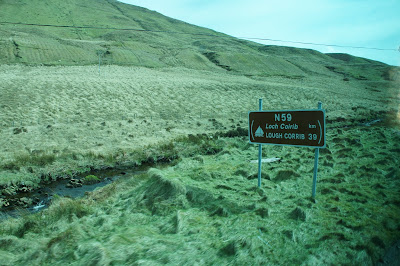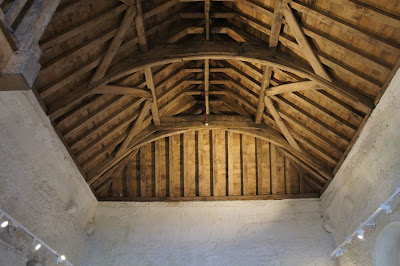Galway Day 12: "I ripped my pants last night..."
If yesterday was good, today was just as wonderful. The morning started early but well, and the events kept getting better as we went on. Our ferry ride back was speedy and smooth. Our trip up to Connemara National Park was beautiful, the park itself even more so. And the final stop at Aughnanure Castle was accompanied by an amazing lady called Jenny, who has her PhD in medieval studies and history. Right on!
My alarm went
off at 5:45 to start the day. The sun rises at approximately 6:40 on the
island, and I wanted to make sure I was mostly packed and ready to go before
heading out to watch it. At 6:30, the group of us made the short trek down to
the beach and got settled. The sun was already peeking over the land, casting
orange shadows over the purple clouds. It was so bright that one house across
the bay had windows glowing yellow from the reflection. I took a video of the
entire time we were out there, which I am sure caught some interesting 6:30AM
conversation. The sea was very peaceful, even if the tide was making its way
in. Everything was still and calm, which is part of why I like the early
morning so much. I miss the days of waking up early to go to the Brew and do
homework before the other college students are even thinking about being awake.
Nothing moves too quickly or too much. Nothing makes unnecessary noise. No
complaining, no stress, no fear. For that stretch of time, I can just be
without worrying about my next move. Which is something that I appreciate
greatly.
Around 7AM, we
decided to go back inside for some quick breakfast. I grabbed some apples and a
kiwi, made a ham sandwich for later, and ate a bowl of corn flakes. Then, I
packed the remainder of my things and said goodbye to the balcony room on
Inishmore. We loaded up the buses and made the five-minute drive back into
Kilronan ferry station. We all spread out on the ferry since no one was really
on board, and then we set off for the mainland. The sky was still overcast, but
there was a weird mist covering the distance that made looking out onto the
approaching landscape eerily cool. Parts of the mountains would come into
better focus as we got closer to them, but for the most part, the whole view
was a shade of hazy blue. Sunspots littered the waves as we sped on. The salt
air filled my lungs and reminded me, once again, of the power of being
surrounded by nature.
Once we landed,
we were met by our driver, Donald. He was supposed to pick up a French group,
but since they were not there yet and we were, he decided to take us on. We
tried our best French (i.e. bon jour
and baguette) as we got on the bus,
and he laughed. Throughout the day, I would learn that he is one of the nicest
people we’ve had drive us in Ireland. He wanted to make sure we saw exactly
what we wanted to see, and listened to every request we made. He took us scenic
routes to places that even our professor had never seen before—which, for a man
who has been on this trip as many times as he has, is saying something. The
first leg of our trip was to Connemara National Park, which is home to one of
the last remaining blanket bogs in the world. The region of Connemara itself is
any land in Co. Galway to the west of Lough Corrib, which is the largest lake
in Ireland.
Even as soon as
we left the ferry dock, the landscape of Connemara opened up into complete
beauty. Lakes were still as glass and reflected the blue sky and clouds above
it. The hills slowly turned into mountains, which were covered with free-range
sheep and other animals. Waterfalls rushed down with brown, mineral-filled
water and landed in the wetlands below. A few tiny cities were dotted along
this road, but not very much activity happened. There was enough business to
survive, and that was about it. Everything else was mountain, lake, or field.
It was truly stunning.
After some time,
we finally made it to Connemara National Park. First, we stopped in the
interpretive center to get some information on peat bogs and why their
preservation is important. Peat (aka partially decomposed, low-nutrient,
anaerobic organic matter) was the main source of fuel in Ireland, especially
during the winter. It is found underneath the top layer of bog environments,
and harvested by digging a trench to make little bricks. When the bricks dry
out, they become perfect fire, furnace, or stove fuel. The blanket bog in
Connemara is unique because it has a layer of charcoal left over from 2000
years ago, when the residents of Ireland were burning down trees to make
fields. The oak forest became a layer of rock, which today keeps water from
draining out. This waterlogged environment is part of what makes the bog
function the way it does.
Science aside, the bog walk itself was wonderful. The hike to the halfway point was much easier than the climb up Torc. We could have climbed all the way up, but we felt like taking our time and enjoying the great view we got even from that point. We could see the blue lakes stretched out over the region, as well as other mountains in the distance. The sun had come out full force, warming our faces and making our spirits rise. I climbed a lot of rocks and had fun getting my hiking boots a little muddy in the bog.
After a few
minutes up there, we went back down to the bottom to grab some lunch and then
make the next leg of our trip: Aughnanure Castle. On the way, we made a literal
one-minute stop at Kylemore Abbey. This is still a functioning Abbey, so we
could not tour it. But we pulled the bus off to the side of the road so that we
could see the amazing structure nestled in next to the mountain, overlooking
the lake. I’m actually pretty sure it is an Irish wizarding school—that’s why
people can’t tour it. It’s just the anti-Muggle charms at work.
The rest of our
drive through Connemara was absolutely stunning as well. We saw Connemara
ponies in their pastures, sheep climbing what were basically sheer cliffs, and
rock fences that went straight up into the air on mountains. It was astonishing
that someone could not only build that, but that it could stay there without
being blown over or broken at some point. We also got to see Killary Harbour,
which is one of the only fjords in Europe outside of the mainland. A fjord is
just a very narrow, very deep, very tall slice of land that was once a glacial
pathway. Thus, the Harbour is surrounded by steep mountains on both sides and a
deep bay below that flows out to sea. The village at the end of the fjord is
called Leenane, which is home to the bar used in the film The Field that we
watched earlier in the term. Pretty neat to see it close up, even if the town
looks a little different now.
The drive took a
little longer yet, but eventually, we arrived at Aughnanure Castle (pronounced
awck-na-nure, like manure—our guide’s words, not mine). The castle was
apparently under renovations for the past year to help with major flooding and
electrical issues, so we were one of the first groups to go through after it
has been reopened. They did not even have their information panels back up on
the walls yet! But, luckily for us, we were guided by the highly knowledgeable
Jenny, who was better than any information panel I’ve ever read. She has her
PhD in some kind of Medieval studies or , though she did not specify exactly
what part. She explained that the O'Flaherty family built the castle as a
personal winter residence circa 1500. They were a very powerful Gaelic
chieftain family who were known in Galway town to be treacherous and
ferociously violent. Beheadings came up, as well as piracy. Perhaps this
reputation was well founded.
Anyway, the
family built the tower house and surrounded their vulnerable land with high,
thick stone walls. They added a banqueting hall later, but it was right over
the part of the river that went underground. Because of this, the hall
eventually caved in on itself and has not even been excavated by archeologists
today. Though that part of the hall will forever remain a mystery, the
remaining one wall suggests that the room was very large and very lavish. The
most expensive materials would have been used here, since it was where foreign
or opposing kings would come to dine. There are beautiful wine leaf details in
the stonework about the windows, symbolizing the O'Flaherty love of imported
red wine. The windows also would have been filled with fine glass rather than
the animal skin of the living quarters. I think things like these are
fascinating evidence of the past, alive right before my eyes.
Inside the
castle were many features of other tower houses around Ireland: a murder hole,
a barricaded door, fireplaces for main rooms, clockwise spiral staircases,
small bathroom corridors, etc. But we learned more about how the O’Flahertys
eventually lost possession of the castle to the English invaders and the
grounds went into ruin. In the 1930s, a descendent of the family was successful
enough to buy the entire property and then donate it back to the Irish
government for free. It has been a heritage site ever since, with major
renovations in the 60s and again just last year. The tour finished there, and
we took a quick group photo in front of the castle for their record.
We left the
grounds just as it began to rain. Donald took us back toward Galway via a local
route that showcases the highest view of Galway. Though the clouds had
gathered, the view was still amazing. We could see our hotel, the Cathedral,
and lots of other landmarks from up that high. He then pulled us back through
town and dropped us at our hotel, where we all scurried inside to get out of
the steady rain. Dinner happened in about a half hour, so we had just enough
time to change and freshen up before eating everything in sight. Full and
happy, we went to bed. We were home.
Tomorrow, we
have a day of class like normal. But on Friday we head out to the Burren to
build a rock wall. It should be a very interesting, immersive experience. And I
can’t wait to see the incredible landscape while we’re there!
♥
photo credit Diana Cleveland






































































































































No comments:
Post a Comment